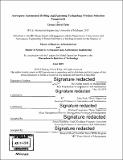Aerospace automated drilling and fastening technology product selection framework
Author(s)
Talus, Zachary David.
Download1119537743-MIT.pdf (5.780Mb)
Other Contributors
Sloan School of Management.
Massachusetts Institute of Technology. Department of Aeronautics and Astronautics.
Leaders for Global Operations Program.
Advisor
Julie Shah and Michael Cusumano.
Terms of use
Metadata
Show full item recordAbstract
Ascent Aerospace is a global tooling and factory automation supplier for the Aerospace industry. Ascent's customers are typically introducing automation for the first time, or have already introduced automation to their production systems and are wary of its challenges. Choosing the appropriate technology is essential in ensuring successful implementation for both Ascent's customers and Ascent itself. Ascent has two different business units that produce equipment to automate the drilling and fastening of aerospace structures. These two units each come with vast product portfolios, and distinct approaches to address customer needs. This thesis focuses on an efficient method of evaluating how Ascent's current products align with customer's requirements, as well as identifying any technology gaps needing further exploration. This thesis argues that Ascent's multiple business units are not currently equipped to advise their customers on investing in the appropriate technology for their production systems. To investigate such a vast solution space, a framework developed by the Systems Engineering Advancement Research Initiative (SEARI) at the Massachusetts Institute of Technology (MIT) is utilized called Multi-Attribute Tradespace Exploration (MATE). Using this framework, a software package called the Product Selection Tool, was developed to analyze how Ascent's product portfolio satisfies the customer's requirements for specific applications. The Product Selection Tool visualizes Ascent's 71 different product offerings on a single graph of utility versus cost per fastener. The interface that displays the graph is dynamic, allowing Ascent's customers to adjust their requirements and preferences in real time, and visualize the sensitivity, or risk, of the recommended solution based on their specific requirements. This new approach allows Ascent to closely work with their customer in selecting a solution, identify areas of concern early on in the product selection process, and introduce cost-effective technology. This model can be applied to a variety of applications that have a vast solution space, reducing the complexity of understanding and communicating one's product line and/or capabilities.
Description
Thesis: M.B.A., Massachusetts Institute of Technology, Sloan School of Management, 2019, In conjunction with the Leaders for Global Operations Program at MIT Thesis: S.M., Massachusetts Institute of Technology, Department of Aeronautics and Astronautics, 2019, In conjunction with the Leaders for Global Operations Program at MIT Cataloged from PDF version of thesis. Includes bibliographical references (pages 65-67).
Date issued
20192019
Department
Sloan School of Management; Massachusetts Institute of Technology. Department of Aeronautics and Astronautics; Leaders for Global Operations ProgramPublisher
Massachusetts Institute of Technology
Keywords
Sloan School of Management., Aeronautics and Astronautics., Leaders for Global Operations Program.